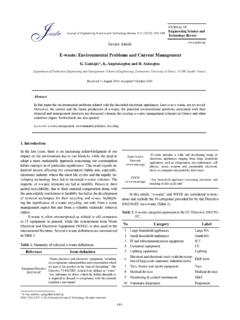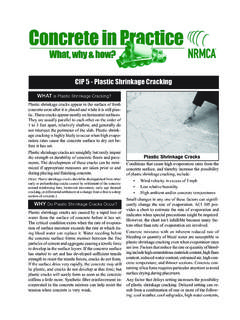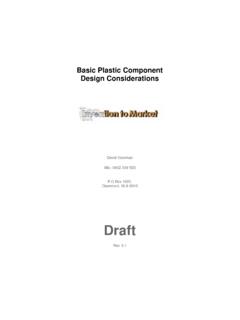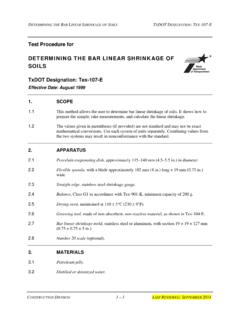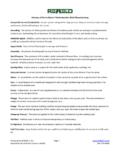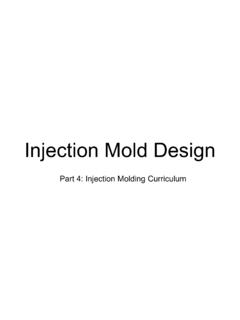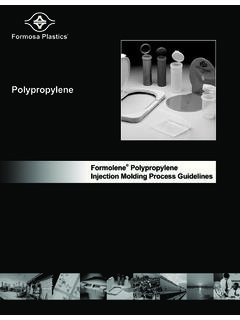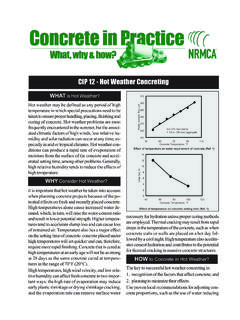Transcription of Application of Soft Computing for the Prediction of ...
1 56 Research ArticleApplication of soft Computing for the Prediction of warpage of Plastic injection molded Parts B. Sidda Reddy 1,*, J. Suresh Kumar2, Vijaya Kumar Reddy2 and G. Padmanabhan31 Department of Mechanical Engineering, R. G. M. College of Engineering & Technology, Nandyal, Kurnool (Dt), 501, India. 2 Mechanical Engineering, University, Hyderabad, Mechanical Engineering, University College of Engineering, University, Tirupati, 4 October 2008; Accepted 15 June 2009 AbstractThis paper deals with the development of accurate warpage Prediction model for plastic injection molded parts using soft Computing tools namely, artificial neural networks and support vector machines. For training, validating and testing of the warpage model, a number of MoldFlow (FE) analyses have been carried out using Taguchi s orthogonal array in the design of experimental technique by considering the process parameters such as mold temperature, melt temperature, packing pres-sure, packing time and cooling time.
2 The warpage values were found by analyses which were done by MoldFlow Plastic Insight (MPI) software. The artificial neural network model and support vector machine regression model have been developed using conjugate gradient learning algorithm and ANOVA kernel function respectively. The adequacy of the de-veloped models is verified by using coefficient of determination. To judge the ability and efficiency of the models to predict the warpage values absolute relative error has been used. The finite element results show, artificial neural network model predicts with high accuracy compared with support vector machine model. Keywords: Plastic injection Molding, warpage , Artificial Neural Networks and Support Vector of Engineering Science and Technology Review 2 (1) (2009) 56-62 JOURNAL OFEngineering Science and Technology materials are commonly used in every area of the industry.
3 The most important reason for this is the material properties of the plastics . Some of these properties are lightness, resistance to corrosion, ease to give shape. The most important is their physi-cal and chemical properties can be changed as desired. Plastic materials can be used in packaging, aerospace, aviation, building and construction, automotive, agriculture, irrigation, sanitation, electrical conduits, and chemical processing plants etc. Plastic In-jection Molding (PIM) is considered the most prominent process for mass producing plastic parts. More than one third of all plas-tic products are made by injection molding, and over half of the world s polymer processing equipment is used for the injection molding process. Plastic injection molding is one of the manu-facturing processes carried out by a consecutive five phases with plastication, injection , packing, cooling and ejection.
4 This proc-ess is complex but highly efficient means of producing a wide variety of three dimensional thermoplastic parts in a large volume of production. During production, quality problems of the plastic parts such as warpage , shrinkage, weld and meld lines, flow mark, flash, sink mark and void are affected from manufacturing proc-ess conditions which include the melt temperature, mold tempera-ture, injection pressure, injection velocity, injection time, pack-ing pressure, packing time, cooling time, cooling temperature etc. One of the most important quality problems is warpage . warpage , is a distortion of the shape of the final injection - molded item, is caused by differential shrinkage; that is, if one area or direction of the article undergoes a different degree of shrinkage than another area or direction, the part will plastication, injection , packing, cooling and ejection processes, the residual stress is produced due to high pressure, temperature change, and relaxation of polymer chains, resulting in warpage of the part.
5 In order to yield a product with high pre-cision, optimum mold geometry and processing parameters must be found. To reduce the cost and time at the design stage, it is important to simulate warpage of the injection molded part. In this study, the warpage values were found by analyses which were done by a computer aided engineering software MoldFlow Plastic Insight (MPI) A predictive model for warpage in terms of the process parameters is then developed by artificial neural networks (ANN) and support vector machines (SVM). The developed mod-el is validated and tested with some of the FE results, which were not used for developing the model. * E-mail address: ISSN: 1791-2377 2009 Kavala Institute of Technology. All rights reserved. 1. Introduction 57B. Sidda Reddy, J. Suresh Kumar, Vijaya Kumar Reddy and G.
6 Padmanabhan/ Journal of Engineering Science and Technology Review 2 (1) (2009) 56-622. Literature ReviewIn the past, Jacques [1] analyzed thermal warpage in injection molded flat parts due to unbalanced cooling. Akay and Ozden [2] measured thermal residual stresses and distortions of injection molded parts and analyzed the effects of temperature gradients. Liu [3] simulated and predicted the residual stress and warpage using a viscoelastic phase transformation model, which assumed the solidified polymer to be a linear solid and the polymer melt to be a viscous fluid. Bushko and Stokes [4-5] used the solidifica-tion of a molten layer of amorphous thermoplastic between cooled parallel plates to model the mechanics of part shrinkage, warpage and the build-up of residual stresses during the injection mold-ing process, assuming thermoviscoelastic behavior of the mate-rial.
7 Kabanemi et al. [6-7] simulated residual stresses and residual deformations using three-dimensional finite element method for a thermo-viscoelastic model and applied it to a complex shape. Mat-suoka et al. [8] developed an injection molding analysis program considering mold cooling and polymer filling-packing-cooling to predict warpage . Hastenberg et al. [9] measured the residual stress distributions in injection molded flat plates using a modified layer-removal method. Jansen et al. [10] systematically studied the ef-fect of processing conditions such as holding pressure, injection velocity, and mold and melt temperatures on shrinkage. Jansen and Titomanlio [11-12] calculated residual stresses and shrinkage of thin products using an elastic model to study the effect of in-mold shrinkage on the final product dimensions and measured the shrinkage under various molding conditions.
8 Choi and Yong-Taek [13] analyzed for shrinkage and warpage using a linear elastic three dimensional finite element method. In the present investigation, the plastic elbow part has been chosen for the Prediction of warpage . A predictive model for warp-age in terms of the process parameters such as mold temperature, melt temperature, packing pressure, packing time and cooling time is then developed using artificial neural networks and sup-port vector machines. The developed model is validated and tested with some of the FE results, which were not used for developing the model. ANN and SVM predicted results are in good agreement with finite element results of warpge. The finite element results show, artificial neural network model predicts with high accuracy compared with support vector machine model.
9 3. Experimental Details The Taguchi s orthogonal array has been implemented for warp-age analyses by considering the process parameters such as mold temperature, melt temperature, packing pressure, packing time and cooling time. The simulation model of elbow plastic part with mesh geometry and injection location, shown in was created. The geometry of this elbow plastic part was discretized using fu-sion mesh by MoldFlow, which is commercial software based on hybrid finite element method for solving pressure, flow and tem-perature fields. The part is made of Indothene 24-MA-040. The Shrinkage of this material is of the order of - mm/mm (2 - 5%) when density is between - g/cm3. When density is between g/cm3, the shrinkage is of the order of - 4%. Actual shrinkage values are dependent on the molding Element analyses of the elbow part are performed using commercial software MoldFlow Plastic Insight for the combination of process parameters shown in Table 1.
10 The combi-nation of process parameters generated by three-level Taguchi s orthogonal array [14]. Finite Element analyses have been carried out for the manufacturing parameters presented in Table 2. The analyses have been carried out on a Genuine Intel x86 Family 6 Model 14 Stepping 12 ~17 processor PC. The warpage values of 36 experiments, for the combination of process parameters are shown in 1. Elbow part with mesh geometry and injection locationTable 1. Process parameters and their levelsTable 2. Manufacturing parameters employed in Moldflow analysisFigure 2. Finite Element results of warpage of 36 ExperimentsControl parameterUnitsLevelsLevel 1 Level 2 Level 3 Mold Temperature (M OT)0C405060 Melt Temperature (MET) 0C175190205 Packing Pressure (PP)MPa90110130 Packing Time (PT)sec246 Cooling Time (CT)sec202530 injection time sInjection pressure 90 MPaCooling channel diameter10 mmBetween cooling channels center distance55 mmBetween cooling channel s Center-parting surface distance25 mmUpper inlet water temperature40 0 CLower inlet water temperature14 0 CNumber of gate4584.
